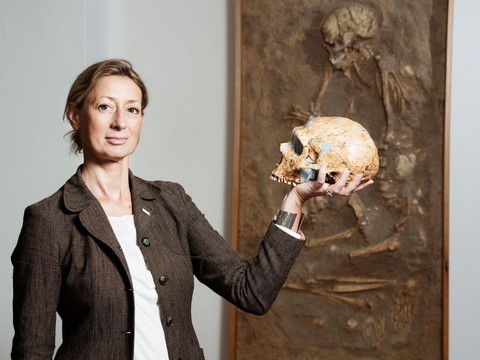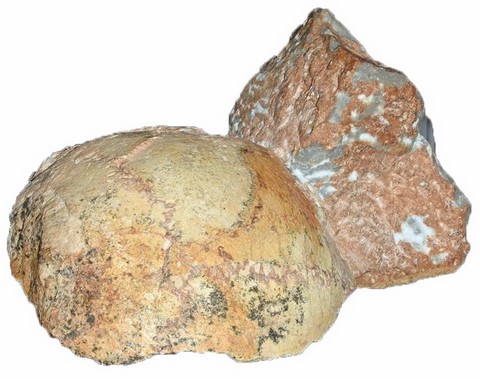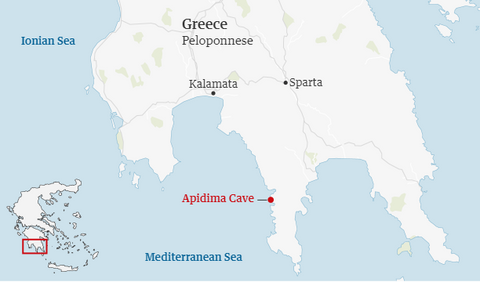Homo Sapiens' first foray into Greece 210,000 years ago

The skulls of Apidima Cave, Greece
A broken skull chiselled from a lump of rock in a cave in Greece is the oldest modern human fossil ever found outside Africa, researchers claim.
The partial skull was discovered in the Apidima cave on the Mani peninsula of the southern Peloponnese and has been dated to be at least 210,000 years old.
If the claim is verified – and many scientists want more proof – the finding will rewrite a key chapter of the human story, with the skull becoming the oldest known Homo sapiens fossil in Europe by more than 160,000 years.
Katerina Harvati, the director of paleoanthropology at the University of Tübingen in Germany, said the skull revealed that at least some modern humans had left Africa far earlier than previously thought and reached further geographically to settle as far away as Europe.
Other fossils of early modern humans found in Israel already point to brief excursions out of Africa, where the species evolved, long before the mass exodus during which Homo sapiens spread from the continent about 70,000 years ago and colonised the world. Paleontologists view the excursions as failed dispersals, with the pioneers ultimately dying out and leaving no genetic legacy in people alive today.
“Our results indicate that an early dispersal of Homo sapiens out of Africa occurred earlier than previously believed, before 200,000 years ago,” Karvati said. “We’re seeing evidence for human dispersals that are not just limited to one major exodus out of Africa.”
For some researchers, however, the claim is bolder than the evidence can bear. Experts contacted by the Guardian doubted whether the skull really belonged to a modern human, and had concerns about the dating procedure. Flaws in either could fatally undermine the scientists’ narrative.
The story of the skull is unusual from the start. It was found during excavations of the Apidima cave, a hole in a limestone cliff that now towers over the sea, in the late 1970s. The fossil was encased in a lump of rock, mere inches from another skull and several bone fragments. The rock itself was wedged high up between adjacent walls of the cave.
Once removed from the cave, the skulls were stored in a museum in Athens but received little attention until recently, in part because they are so damaged and incomplete. The second skull, which retains a face, was studied the most and identified as Neanderthal. The first skull, consisting only of the back of the skull, was largely ignored.


Harvati and her co-workers set out to examine both. They took CT scans of the fossils and from these created virtual 3D reconstructions. The 3D models were then compared with skulls from various ancient Homo sapiens, Neanderthals and modern humans.
Writing in the journal Nature, the scientists describe how their analysis confirmed the second skull, which has a thick, rounded brow ridge, as Neanderthal. But to their surprise, the other partial skull most closely matched that of a modern human. The main evidence was the rounded back and the lack of a classic Neanderthal bulge that looks like hair tied back in a bun.
“The part that is preserved, the back of the skull, is very diagnostic in differentiating Neanderthals and modern humans from each other and from earlier archaic humans,” Harvati said.
Scientists on the team then dated the fossils with a method that relies on the radioactive decay of natural uranium in the buried remains. The tests found the Neanderthal skull to be at least 170,000 years old and the Homo sapiens skull at least 210,000 years old, with the rock encasing them more than 150,000 years old. The range of ages could be explained by the skulls mixing together in a mudflow that later solidified in the cave.
If at least some early modern humans left Africa more than 210,000 years ago, they may have settled in the Levant before expanding west into Europe, which was already home to Neanderthals. Last year, a modern human fossil dating to nearly 200,000 years old was found in the Misliya cave in northern Israel. Any early human pioneers who did reach Europe died out there, before the Neanderthals themselves were replaced by an influx of Homo sapiens about 40,000 years ago.
Some scientists are calling for more evidence. Warren Sharp at the Berkeley Geochronology Center in California said the team’s tests on the supposedly modern human skull had produced wildly different dates, a sign that uranium may have been lost from the bones over time. “If so, the fossil’s calculated age is too old, and its true age is unknown, calling into question the premise of the paper,” he said.
Juan Luis Arsuaga, a Spanish palaeoanthropologist, said he was not convinced the skull was from an early modern human.
“The fossil is too fragmentary and incomplete for such a strong claim,” he said. “In science, extraordinary claims require extraordinary proofs. A partial braincase, lacking the cranial base and the totality of the face, is not extraordinary evidence to my mind.”
John Hawks, a palaeontologist at the University of Wisconsin – Madison, voiced similar doubts:
“Can we really use a small part of the skull like this to recognise our species?” he said. “The storyline in this paper is that the skull is more rounded in the back, with more vertical sides, and that makes it similar to modern humans. I think that when we see complexity, we shouldn’t assume that a single small part of the skeleton can tell the whole story.”
Interview with Katerina Harvati
Katerina Harvati is the chief for Paleoanthropology at the Senckenberg Center at Tübingen University.
Harvati: We began by examining the skulls, which were only partially preserved and which were of course not intact, with the help of a computer tomograph. On the basis of the pictures which we obtained, we have virtually reassembeld the single bone fragments with the help of the computer, in such a way that we were then able to measure the skulls very precisely and to compare them with other finds. Additionally, we were able to pin down the exact age of the skulls.
SPIEGEL: With what results?
Harvati: The better preserved skull is ca 170,000 years old and belongs to a Neanderthal. The less well preserved skull is a good 210,000 years old and belongs to a modern human. It’s happens to be the second skull fragment, which scientists have for many years treated like a poor relative to the better preserved one, which turned out to be especially remarkable.
SPIEGEL: What makes it such a sensation ?
Harvati: It was known that Homo Sapiens left Africa early, in a first wave of migration. But up to now, we knew only fossils which were 180,000 years old, and these were found in what is today Israel. Now it turns out that modern man left Africa more than 200,000 years ago and that he moved considerably farther than he was supposed to have done sofar.
SPIEGEL: What impelled him to go to Europe?
Harvati: This is something which in our present state of knowledge we can only speculate about. It might have been climate changes, which drove game animals northwards. The hunters would then have followed them. It could be also that it was new technological advances, or changes in terrain features, which finally opened the way to migrations to Europe. The certainty is that, after this first wave of migration, Homo sapiens disappeared again from Europe, he died out here.
Harvati: Genetically, we Europeans are descendants from humans who arrived from Africa in a second, much later migration of Homo Sapiens, which occurred about 50,000 to 45,000 years ago. There is only one place where the early migrants may have left genetic traces going back 200,000 years ago.
Harvati: In the genetic make-up of the Neanderthals. Homo Sapiens hit upon this same human species, with which he shared common ancestors, than he did the second time around, 50,000 years ago. Why was it that, after their first meeting, it was Homo Sapiens who died out, whereas after the second one, it was Neanderthal man - that's a thrilling question. Why didn’t modern man succeed to survive here in his first migration wave ? Maybe there were not enough people who came from Africa to Europe ? Were the groups in which Homo Sapiens lived too small then ? Did they miss some decisive element of technology, or did they nourish themselves differently than they did later ? It’s a mystery I will be most eager to help solving.
Interview conducted by Veronika Hackenbroch
Translated from the German by Anne-Marie de Grazia
Go to the original article in Der Spiegel, July 12, 2019


